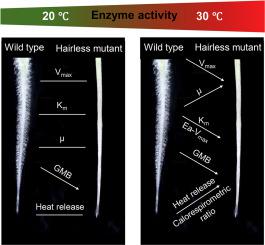Soil Biology and Biochemistry ( IF 9.7 ) Pub Date : 2020-06-01 , DOI: 10.1016/j.soilbio.2020.107872 Xuechen Zhang , Yakov Kuzyakov , Huadong Zang , Michaela A. Dippold , Lingling Shi , Sandra Spielvogel , Bahar S. Razavi

|
Root hairs proliferation and warming strongly influence exudate release, enzyme activities and microbial substrate utilization. However, how the presence of root hairs regulates those processes in the rhizosphere under elevated temperature is poorly known. To clarify these interactions, a wild type maize (with root hairs) and its hairless mutant were grown for 3 weeks at 20 and 30 °C, respectively. We combined zymography (localize hotspots of β-glucosidase) with substrate-induced respiration and microcalorimetry to monitor exudate effects on enzyme kinetics, microbial growth and heat production in the rhizosphere hotspots in response to warming.
Root hairs effects were more pronounced at the elevated temperature: i) β-glucosidase activity of the wild type at 30 °C was 21% higher than that of the hairless maize; ii) temperature shifted the microbial growth strategy, whereas root hairs promoted the fraction of growing microbial biomass; iii) Km and the activation energy for β-glucosidase under the hairless mutant was lower than that under wild maize. These results suggest that microorganisms inhabiting hotspots of the wild type synthesized more enzymes to fulfill their higher energy and nutrient demands than those of the hairless mutant. In contrast, at higher temperature the hairless maize produced an enzyme pool with higher efficiencies rather than higher enzyme production, enabling metabolic needs to be met at lower cost. We therefore conclude that root hairs play an important role in regulating enzyme systems and microbial growth to adapt to climate warming.
中文翻译:

根际热点:根毛和变暖控制微生物效率,碳利用和能量产生
根毛的增殖和变暖强烈影响分泌液的释放,酶活性和微生物底物的利用。然而,在高温下,根毛的存在如何调节根际中的那些过程却鲜为人知。为了阐明这些相互作用,将野生型玉米(具有根毛)及其无毛突变体分别在20和30°C下生长3周。我们将酶谱分析法(将β-葡萄糖苷酶的热点定位)与底物诱导的呼吸和微量量热法相结合,以监测渗出液对变暖对根际热点中酶动力学,微生物生长和产热的影响。
在升高的温度下,根毛的作用更为明显:i)在30°C时,野生型的β-葡萄糖苷酶活性比无毛玉米高21%;ii)温度改变了微生物的生长策略,而根毛促进了微生物生物量的增长;iii)千米无毛突变体对β-葡萄糖苷酶的活化能低于野生玉米。这些结果表明,与无毛突变体相比,居住在野生型热点中的微生物合成了更多的酶来满足其更高的能量和营养需求。相反,在较高温度下,无毛玉米产生的酶库效率更高,而不是更高的酶产量,从而能够以较低的成本满足代谢需求。因此,我们得出结论,根毛在调节酶系统和微生物生长以适应气候变暖中起着重要作用。


























 京公网安备 11010802027423号
京公网安备 11010802027423号